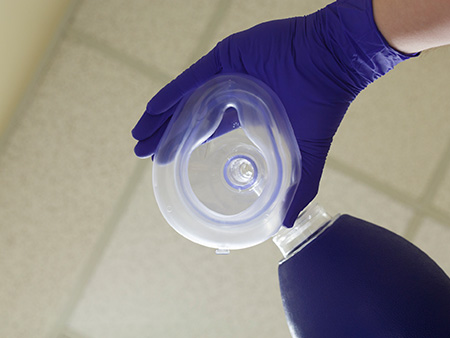 New research published in the New England Journal of Medicine shows that using bag-mask ventilation during intubation improves outcomes and could potentially change the standard of care.
New research published in the New England Journal of Medicine shows that using bag-mask ventilation during intubation improves outcomes and could potentially change the standard of care.
Intubation is a dangerous, but necessary procedure for many critically ill patients, and thousands of Americans die each year during the process. More than 1.5 million patients undergo tracheal intubation each year in the United States. Up to 40 percent of tracheal intubations in the intensive care unit are complicated by hypoxemia, which may cause damage to the brain and heart, and 2 percent of people suffer cardiac arrest, a sudden failure of heart function that is frequently fatal.
Some doctors are hesitant to use bag-mask ventilation during tracheal intubation due to fears of causing aspiration, but co-author and University of Alabama at Birmingham Division of Pulmonary, Allergy and Critical Care Medicine Assistant Professor Derek Russell, M.D., says that, through the Preventing Hypoxemia with Manual Ventilation During Endotracheal Intubation (PreVent) trial, he and his colleagues found bag-mask ventilation was effective in preventing low oxygen levels without any evidence that it increases aspiration risk.
In this multicenter randomized controlled trial conducted in seven intensive care units in the United States, PreVent investigators, led by Jonathan Casey, M.D., of Vanderbilt University, randomly assigned adults undergoing tracheal intubation to receive either ventilation with a bag-mask device at the time of induction or no ventilation until oxygen levels fell. Among the 401 patients enrolled, 113 at UAB, the lowest median oxygen saturation was 96 percent in the bag-mask ventilation group as compared to 93 percent in the no-ventilation group, which was statistically significant. A total of 21 patients in the bag-mask ventilation group had severely low oxygen levels, as compared with 45 patients in the no-ventilation group (also statistically significant).
“Our findings have changed my practice,” Russell said. “These findings will change the way we train people to perform this procedure given the solid evidence provided by this randomized clinical trial.”
|
Up to 40 percent of tracheal intubations in the ICU are complicated by hypoxemia. |
Russell says his colleagues in the division have also taken notice to these findings and have begun to change their standard of care.
Speaking of the role that he and UAB play in this study and others like it: “It is very rewarding to be a part of something that can have a profound impact on medicine,” Russell said.
Patients enrolled in the trial suffered from an array of critical illnesses, including sepsis, COPD and acute respiratory distress syndrome.
This clinical trial is part of the Preventing Hypoxemia with Manual Ventilation During Endotracheal Intubation (PreVent) trial. PreVent is a randomized trial comparing manual ventilation between induction and laryngoscopy to no manual ventilation between induction and laryngoscopy during endotracheal intubation of critically ill adults.